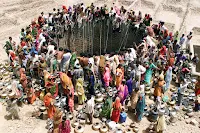 |
| Save water today for a better tomorrow (pic source: google images) |
विश्व जल सप्ताह २३ - २८ अगस्त
जल, जीवन की ज्योति, जल बिना जीवन की कल्पना करना भी कठिन है. न सिर्फ मनुष्यों अपितु समस्त प्राणियों एवं जीव- जंतुओं की उत्तरजीविता (सर्वाइवल) के लिए भी पानी की उपस्थिति अनिवार्य है.
पानी न सिर्फ हमारे कंठ को तृप्त करता है, अपितु पानी पर ही हमारी समस्त भौतिक अवशकताएं, हमारा भोजन, हमारी ऊर्जा, हमारी अर्थव्यवस्था और हमारा इकोसिस्टम आश्रित है.
Water is at the core of sustainable development and is critical for socio-economic development, healthy ecosystems and for human survival itself. It is vital for reducing the global burden of disease and improving the health, welfare and productivity of populations.
 समय के साथ बढ़ती हुए आबादी, घटते हुए जंगल एवं प्राकृतिक जल-स्रोतों का गिरता हुआ स्तर चिंता का विषय है. एक अनुमान के अनुसार आज समस्त विश्व के अनेकों क्षेत्रों में करीब ७४८ करोड़ लोगों को पीने के लिए स्वच्छ जल उपलब्ध नही है. जिस तीव्र गति से आज बढ़ती हुए आबादी के कारण नगरों का विस्तार होता जा रहा है, जल की उपलब्धता उतनी ही कम होती जा रही है.
समय के साथ बढ़ती हुए आबादी, घटते हुए जंगल एवं प्राकृतिक जल-स्रोतों का गिरता हुआ स्तर चिंता का विषय है. एक अनुमान के अनुसार आज समस्त विश्व के अनेकों क्षेत्रों में करीब ७४८ करोड़ लोगों को पीने के लिए स्वच्छ जल उपलब्ध नही है. जिस तीव्र गति से आज बढ़ती हुए आबादी के कारण नगरों का विस्तार होता जा रहा है, जल की उपलब्धता उतनी ही कम होती जा रही है.
अगर धरा पर उपलब्ध जल को उसके उपयोगानुसार बांटकर देखा जाये तो पानी का सबसे ज़्यादा उपयोग ७० % कृषि आधारित क्षेत्रों में किया जाता है. साथ ही औद्योगिक एवं ऊर्जा क्षेत्रों में अनुमानतः करीब २०% और घरेलु उपयोग में १० % जल का उपयोग होता है.
Water can pose a serious challenge to sustainable development but managed efficiently and equitably, water can play a key enabling role in strengthening the resilience of social, economic and environmental systems in the light of rapid and unpredictable changes.

About 1 billion people will still lack access to safe water and even more lack access to basic sanitation living without electricity and lack of food.
According to an estimate, total of 748 million people still do not have access to drinking water source, lacking access to improved sanitation and over one billion still practicing open defecation.
As countries develop and populations grow, global water demand (in terms of withdrawals) is projected to increase by 55% by 2050. Already by 2025, two thirds of the world’s population could be living in water-stressed countries if current consumption patterns continue.
According to global water distribution, agriculture is by far the thirstiest consumer of water globally, accounting for 70% of water withdrawals worldwide.As the demand keeps on increasing, world agriculture will need to produce 60% more food globally, and 100% more in developing countries.Industry and energy together account for 20% , while Domestic sector accounts for 10% of total water use.
 As of consumption in cities which are over-loaded due to migrants from small urban areas, which have limited capacity to deal with this rapid change, and the growth will also lead to increase in the number of people living in slums, which often have very poor living conditions, including inadequate water and sanitation facilities. Therefore, the development of water resources for economic growth, social equity and environmental sustainability will be closely linked with the sustainable development of cities.
As of consumption in cities which are over-loaded due to migrants from small urban areas, which have limited capacity to deal with this rapid change, and the growth will also lead to increase in the number of people living in slums, which often have very poor living conditions, including inadequate water and sanitation facilities. Therefore, the development of water resources for economic growth, social equity and environmental sustainability will be closely linked with the sustainable development of cities.
Depletion in water level has also affected our ecosystem in drastic ways, endangering lives of many species due to climate change.
 |
| Save water before its too late (pic source: google images) |
There is strong need to promote sustainable development and to facilitate inspired action...
Because its now or never...
We should not forget that Water is for All...
Dr. P Pathak
@swavalambanrehab
.
Comments
Post a Comment